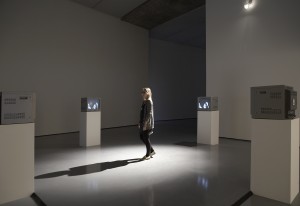Peter Campus: A Profile
Peter Campus’ deep and consummate engagement with video demonstrates his continued fascination with the extraordinary potential of this complex and continuously evolving medium. A major figure from the first generation of artists to explore video as a medium for fine art discourse, Campus studied experimental psychology at Ohio State University (1955-60) and film-making at the City College Film Institute in New York (1961-62). This period of study led directly to a decade of commercial film and television production before beginning his career as an artist.
His early work explored the complex interplay between video and self-image through the development of a participatory interaction between the spectator, the artist and the space of perception. He has greatly enriched the genre of artists’ video with seminal early analogue tapes such as Double Vision (1971) and Three Transitions (1973) and via an extended series of powerful, directly engaging closed-circuit installations including Kiva, (1971), Stasis (1973) and Lus (1977).
Returning to work with the medium in 1995 after a seventeen-year break exploring the potential of photography and computer drawing, Campus has built on the ideas and experiences developed through these media to create a corpus of new digital video works, and this new work further extends and deepens his oeuvre through an exploration of natural sound and digital montage. In Video Ergo Sum (1999) Campus presented a series of eight brief looped image sequences from nature on a line of screens set into the gallery wall. Each element of this series contains a poetic intensity and a painterly visuality.
Infused with the philosophical implications of quantum mechanics, Campus’ most recent digital works such as edge of ocean (2003) engage directly with images of cyclic movement and the ambiguity and mystery of temporal flow in the natural world. Campus’ exploration of painterly abstraction with the video image has been further extended in his most recent work. For example, line of fire (2008) truncates a high-definition wide-screen image of a seascape into three distinct bands of undulating colour; the foreground a pulsating red/orange, the sea pale green and ultramarine and the sky above a blend of pastel blue. These abstracted electronic colours, further simplified into elemental coloured blocks, shimmer and shift in harmony with the timeless and inexorable roar of the distant ocean on the ambient soundtrack.
Over nearly four decades Peter Campus’ commitment to exploring the spatially transformative power of lens-based and electronic moving images has produced a substantial and enduring contribution to the video medium. Across this period his work has helped to redefine and extend the medium by challenging preconceptions about its capabilities and potential with a rigorous and perceptive understanding that has inspired the generations of artists who have followed.
Chris Meigh-Andrews, 100 Video Artists, Exit Publications, Madrid, 2009
